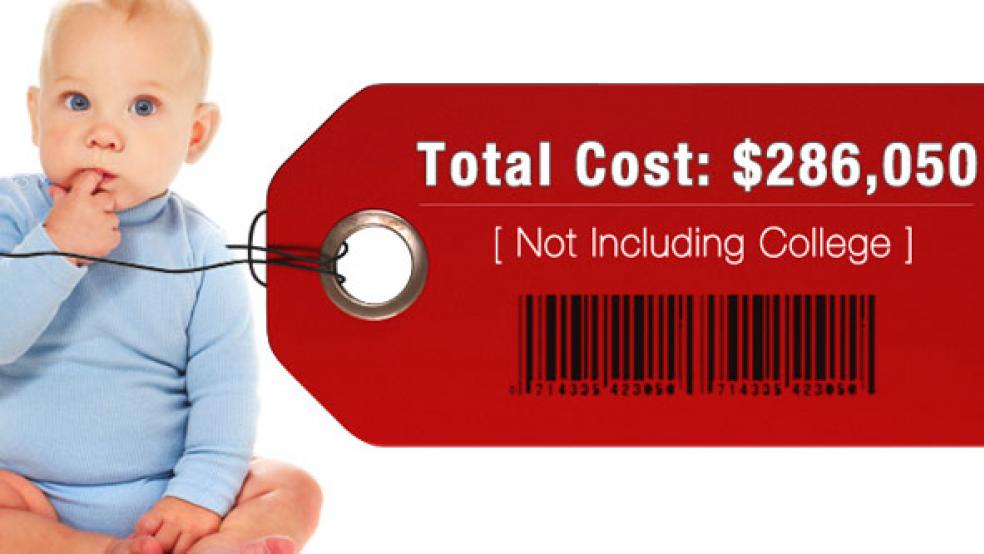This is the second piece in a series that will examine the impact of a potential baby dearth in America. The recession is pushing the birth rate down, women are waiting longer to have children and the cost of raising a child is skyrocketing. Fewer babies means fewer young people to support an aging population , threatening already-strained social programs. Has America’s baby bubble burst?
Meet Mrs. Hoffman’s dream family: three children, each two years apart, two girls and a boy. She’d work from home in their three bedroom home in a quaint New Jersey suburb, her husband commuting to New York City. She’d have it all — the house, the husband, the fulfilling career, and a bustling household of children playing tag in the manicured front yard. It’s the iconic vision of the American dream. But last year, Hoffman’s dream evaporated. After much deliberation, the Hoffmann’s decided they couldn’t afford a third child. They could barely afford the two they already had.
Whether it’s hospital costs, diapers, day care, or the ever increasing cost of a college education, children are expensive, and getting more so. Due to the recession, couples are starting to consider the financial realities having a family — for many, that means downsizing or skipping out on baby-making altogether.
Three Strikes Against Children
The birth rate has dropped over 8 percent since 2007. Women are having an average of 2.01 children over their lifetime, below the population replacement rate of 2.10 (a number that was holding steady before the recession). If the downtrend continues, it could create a small workforce supporting a large aging population with less revenue for expensive tax-funded social programs seniors depend on.
In addition to the rising costs of children, women are marrying later and waiting longer to have children, lowering their chances of conceiving, and facing staggering fertility treatment costs when they get there. With all these forces compounding, it’s possible the birth rate will continue to fall even after the economy recovers — a shift that has undermined the social systems and economies in many developed countries, including Japan and Italy. Right now, the birth rate in the U.S. appears to be teetering on the edge of a cliff, ready to nosedive at any moment.
How Much Is That Baby in the Window?
In 2009, the Department of Agriculture estimated the total before-college cost of raising a child was $286,050 — about $11,700 per year today, and $21,600 a year by the time they’re 18. With college, the cost nearly doubles, not to mention the costs many parents face during a recession when their college grad shows up at their doorstep expecting to move back in. Housing and child care were two of the biggest expenses, 31 percent and 17 percent respectively, and 50 percent higher for those who live in urban areas. The U.S. is becoming more urbanized every year — 90 percent of the population is expected to live in cities or suburbs by 2050. For a newborn in New York City, the average family spends up to $16,250 per year on child care alone.
Pamela Paul, author of Parenting, Inc., writes, “From the moment the self-pregnancy test confirms the happy news, the sales pitches begin: a shower of catalogs hawking the very best in organic onesies; lavender-scented diaper creams and designer rubber duckies; a never-ending cascade of DVDs and baby classes that promise to make your child smarter, socially adept and bilingual before age three … Time-strapped mothers and fathers are the perfect mark for the mammoth ‘parenting’ industry.”
Linda Milkes, 41, from Basking Ridge, NJ, and her husband originally wanted children, but couldn’t imagine adding a $286,000 bill to their expenses. They ultimately decided to remain childless. “We have a pretty decent lifestyle, we enjoy going out and doing things and traveling when we can,” she says. “I remember hearing from years back that it costs about $100,000 to raise a kid, not counting college. Once I heard that figured updated to $250,000, I was like ‘oh man, there’s no way we could afford this.’”
Many Americans want more children than they actually conceive and deliver. Surveys show that 26 percent of Americans say three children is was ideal, 46 percent say two — only 3 percent say one child and 3 percent say zero. Yet birth data tells a different story. A whopping 18 percent of women now have no children, up 80 percent since 1996, and nearly 25 percent have one child. The average is still two, close to replacement rate, but as Phillip Longman, author of The Empty Cradle: How Falling Birthrates Threaten World Prosperity And What to Do About It says, “If the average woman has to have 2.1 kids [to replace the population] and 18 percent of women are having no kids over their lifetime, then women who do have kids have to have a whole lot more than two.”
Wrinkle Cream and Fertility Pills
Back in the 1970s, the average age of a woman’s first birth in the U.S. was 21. Today it’s 25 — and higher for states like Connecticut, Massachusetts and New Jersey, where it’s 27. Although the birth rate declined in 2009, it actually rose for women ages 40 to 44, the only age group to do so. Celebrity moms over 40 like Jane Seymour and Madonna make it appear effortless to get pregnant at this age, but when women wait until they’re in their 30s and 40s to have children, the chances of conceiving drops dramatically and they’re more likely to use fertility treatments. In vitro fertilization in the U.S. will set you back some $15,000 with each attempt — more than any other developed country. In addition, many babies born through IVF and other methods are premature, increasing the initial health care costs for the child.
“We have a generation of people who are taking longer to get established,” says Judith Daniluk, a psychologist at the University of Calgary in British Columbia who specializes in childbirth trends. “It used to be, ‘get out of high school, get your university degree, hook up with a partner, get a home, have kids.’ We’ve probably pushed that by about eight to 10 years. By the time a couple gets the things they need in place to parent, they’re into their late 30s.”
A Shifting Lifestyle
With more women working, childbearing has become a difficult choice, especially at a time when two incomes are essential. “As more and more couples, including those who have economic resources, both end up pursuing careers, that luxury of being able to have one parent stay home and raise the kids is just not a luxury that many people can afford any more,” says Daniluk. Yet, it doesn’t make financial sense for both parents to work if the majority of one partner’s paycheck goes to childcare. Eat, Pray, Love author Elizabeth Gilibert, who is childless by choice, said, “I didn't think I had the support to both have [kids] and continue on this path that was really important to me. I wasn't married to a man who wanted to stay home and raise kids. So...”
With the rise of birth control, some wonder if young women are becoming more disconnected with fertility and childrearing. Gone are the home economics and family planning classes (and few women were sad to see them go). Women want control and freedom in their lives — something children can impede on. “Having kids is such a huge financial responsibility, and once you’re in it, you’re stuck, and you have to do whatever you’ve got to do — maybe work extra hours or take a second job, just to provide for your kid. It just takes away freedom,” says Milkes.
With all of these forces intersecting, the dip in the birth rate since 2007 starts to look like the beginning of a new era – one with smaller families and smaller workforces. “It’s important for people to remember how anomalous the baby boom was,” says Longman. “The long-term trend [for the birth rate] has been down down down.”
Related Links:
Driven by the Recession, a Baby Bust Hits the U.S. (The Fiscal Times)
Children Are Big Ticket Items (Psychology Today)
No Babies? (The New York Times)



